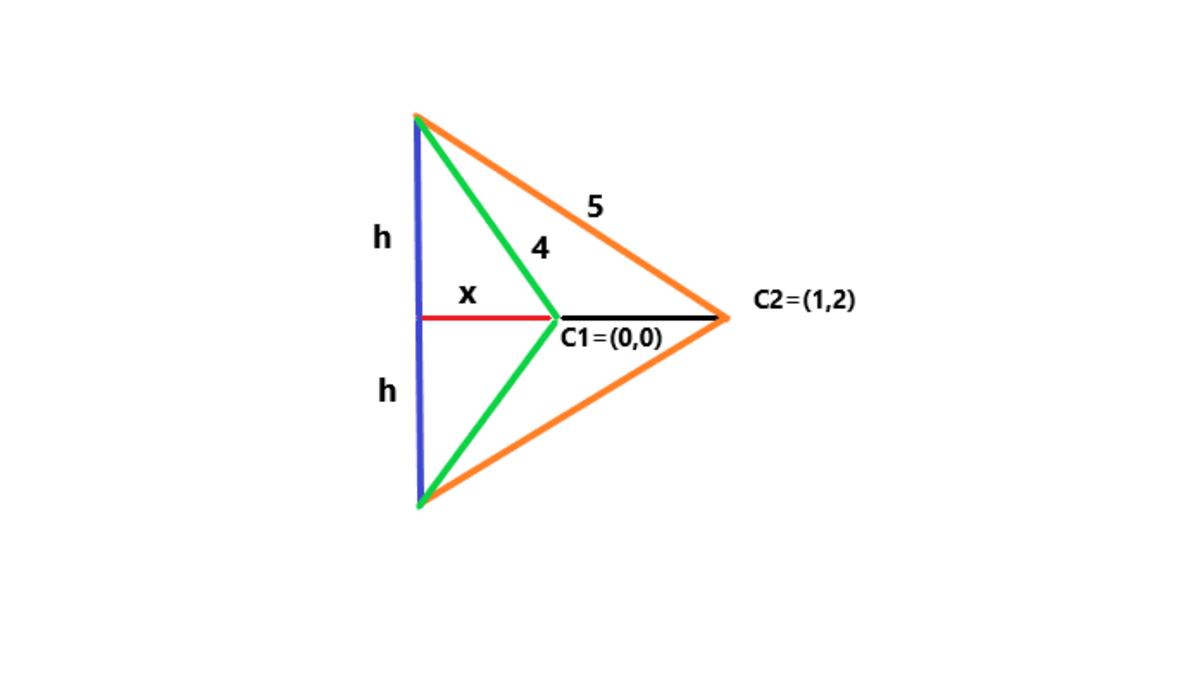A common chord
Find the distance between the intersection points of the two circles x 2 + y 2 = 1 6 and ( x − 1 ) 2 + ( y − 2 ) 2 = 2 5 .
The answer is 7.797.
This section requires Javascript.
You are seeing this because something didn't load right. We suggest you, (a) try
refreshing the page, (b) enabling javascript if it is disabled on your browser and,
finally, (c)
loading the
non-javascript version of this page
. We're sorry about the hassle.
5 solutions

The distance between the centres = 1 2 + 2 2 = 5
By Pythagoras theorem,
4 2 − h 2 = x 2 5 2 − h 2 = ( x + 5 ) 2
Solving the equations, we have x = 5 2 and h = 5 7 6
The length of the chord = 2 h ≈ 7 . 7 9 7
Actually, this is probably the best way of doing it. Well done👏🏽
The second circle's center is 1 2 + 2 2 = 5 away from the origin, so we can change its equation to ( x − 5 ) 2 + y 2 = 2 5 (representing a rotation about the origin) and still preserve the distance between intersection points to make the math a little easier.
The circles x 2 + y 2 = 1 6 and ( x − 5 ) 2 + y 2 = 2 5 intersect at ( − 5 2 5 , ± 5 2 9 5 ) , and the distance between these two points is 5 4 9 5 ≈ 7 . 7 9 7 .
The first circle is centered at O 1 ( 0 , 0 ) with a radius of r 1 = 4 . The second circle is center at O 2 ( 1 , 2 ) with a radius of r 2 = 5 .
Let the first intersection point be A , then by drawing the triangle O 1 O 2 A , we find that
cos θ = 2 ( 4 ) 5 ( r 1 2 + ( 1 2 + 2 2 ) − r 2 2 ) = − 2 5 1
where θ = ∠ A O 1 O 2
It follows that sin θ = 2 5 1 9
Hence chord length = 2 r 1 sin θ = 2 ( 4 ) 2 5 1 9 = 7 . 7 9 7
Line x + 2 y = − 2 came after substituting first circle to second or y = 2 − 2 − x touches either circle at ( 5 − 2 − 3 0 4 , 1 0 − 8 + 3 0 4 ) , ( 5 − 2 + 3 0 4 , 1 0 − 8 − 3 0 4 ) , again found by substitution of the line to either circle, it's the distance between those two points which can also be approximated at between ( − 3 . 8 8 7 , 0 . 9 4 3 ) and ( 3 . 0 8 7 , − 2 . 5 4 4 ) to 7 . 7 9 7 6 .
Let the two intersecting points of the two circles be P 1 ( x 1 , y 1 ) and P 2 ( x 2 , y 2 ) . Then ( x 1 , y 1 ) and ( x 2 , y 2 ) satisfy the two equations.
{ x 2 + y 2 = 1 6 ( x − 1 ) 2 + ( y − 2 ) 2 = 2 5 . . . ( 1 ) . . . ( 2 ) .
From ( 2 ) :
x 2 − 2 x + 1 + y 2 − 4 y + 4 − 2 x − 4 y ⟹ x + 2 y = 2 5 = 4 = − 2 Note that ( 1 ) : x 2 + y 2 = 1 6 .
The equation x + 2 y = − 2 is the straight line passes through P 1 and P 2 . We need to find the length
P 1 P 2 = ( x 1 − x 2 ) 2 + ( y 1 − y 2 ) 2 = x 1 2 − 2 x 1 x 2 + x 2 2 + y 1 2 − 2 y 1 y 2 + y 2 2 = 3 2 − 2 x 1 x 2 − 2 y 1 y 2 = 3 2 + 2 4 + 5 2 4 = 5 3 0 4 ≈ 7 . 7 9 7 Note that ( 1 ) : x 2 + y 2 = 1 6 By Vieta’s formula (see note)
Note: From x + 2 y = − 2 , ⟹ y = − 2 x + 2 . Putting it into ( 1 ) , we have:
x 2 + ( − 2 x + 2 ) 2 x 2 + 4 x 2 + 4 x + 4 5 x 2 + 4 x − 6 0 ⟹ x 2 + 5 4 x − 1 2 = 1 6 = 1 6 = 0 = 0
By Vieta's formula , we have x 1 x 2 = − 1 2 .
Similarly, x = − 2 ( y + 1 ) , 4 ( y + 1 ) 2 + y 2 = 1 6 ⟹ 5 y 2 + 8 y − 1 2 = 0 , ⟹ y 1 y 2 = − 5 1 2 .